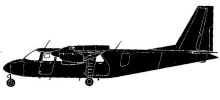
ASN Wikibase Occurrence # 321594
| Date: | Friday 19 December 2008 |
| Time: | 11:10 |
| Type: |  Britten-Norman BN-2A-20 Islander |
| Owner/operator: | Air Vanuatu |
| Registration: | YJ-RV2 |
| MSN: | 145 |
| Year of manufacture: | 1970 |
| Engine model: | Lycoming IO-540-K1B5 |
| Fatalities: | Fatalities: 2 / Occupants: 10 |
| Aircraft damage: | Destroyed, written off |
| Category: | Accident |
| Location: | 25 km SE of Olpoi-Lajmoli Airport (OLJ) -
 Vanuatu Vanuatu
|
| Phase: | En route |
| Nature: | Passenger - Scheduled |
| Departure airport: | Olpoi-Lajmoli Airport (OLJ/NVSZ) |
| Luganville/Espirítu Santo-Pekoa International Airport (SON/NVSS) | |
| Investigating agency: | TAIC |
| Confidence Rating: |
A Britten-Norman BN2A-20 Islander, registered YJ-RV2, was on a regular passenger service between Lajmoli (OLJ) and Pekoa International Airport (SON), Vanuatu when it struck the side of a mountain range. The planes sole pilot died while the front-seat passenger died later of his injuries. Two other passengers were seriously injured, and all the other passengers suffered minor injuries.
The flight an extra return service put on to pick up passengers delayed by a flight cancelled the day before. The flight took off from Pekoa at 10:16 and landed at Lajmoli at 10:43. While the flight was inbound, the local agent weighed the passengers and their bags in preparation for the return flight. The agent informed the pilot of the planned load of 9 passengers and baggage, and that the aircraft would likely be at about maximum allowable weight. The pilot was reported to have advised the agent that he was happy to continue and instructed him to load the aircraft.
At 10:55 the pilot started the engines and taxied the aircraft for grass runway 14. Flight NF261 took off at 10:58 and at 11:00 the pilot called Santo air traffic services on the high frequency (HF) radio, reporting airborne and climbing to 7000 feet. He gave an estimated time of arrival at Santo of 11: 30.
The plane climbed slower than usual. The pilot followed the coastline south and approaching the village of Wunavae turned left inland. Passengers later commented that the aircraft flew in a direct line towards the rising hilly ground and, based on their previous flying experiences, crossed several ridges at a lower-than-normal height. The passengers also commented that the pilot increased power on the engines as they flew in an easterly direction.
The passengers became increasingly concerned about the low height of the aircraft as it flew directly at a right-angle towards the last ridgeline before crossing over into Big Bay. Some of the passengers described the pilot closing the throttles and shutting down the engines as they approached the ridgeline. At about the same time they heard the aircrafts stall warning. Shortly afterwards, the aircraft struck the trees and bush and quickly came to a halt. No communication was heard from the pilot during this time.
The accident site was at about 1200 m above sea level, on the western-facing slope of a heavy bush-covered mountainside, some 25 m below a saddle on the ridgeline
FINDINGS:
1 The pilot was appropriately licensed to fly the aeroplane, but his route and aerodrome qualification had been allowed to lapse. However, this lapse was unlikely to have contributed to the accident.
2 There was no evidence that the pilot was not fit to conduct the flight, but he was observed by the local agent and passengers to be less communicative than usual, both before and during the flight.
3 The aeroplane had been maintained in accordance with approved standards and there was no evidence of mechanical failure that could have contributed to the accident.
4 The weather was suitable for the pilot to maintain appropriate terrain separation visually.
5 The aeroplane was overloaded by at least 7%, which affected its climb performance and made it unlikely that it would be able to cross the final ridge without deviating from the path flown by the pilot.
6 The aeroplane did not have sufficient height margin to approach the lee of the ridge where downdraughts were foreseeable, and the pilot had not approached the ridge from a direction that would have afforded him an escape route when he decided to abort the crossing.
7 The poor configuration of the seat belts in the aeroplane increased the risk of injury to the occupants, and may have contributed to the death of one passenger.
8 The chances of survival for those passengers who survived the impact were reduced by their decision to leave the accident site.
Accident investigation:
 |
|
Sources:
Location
Revision history:
| Date/time | Contributor | Updates |
|---|
The Aviation Safety Network is an exclusive service provided by:


 ©2024 Flight Safety Foundation
©2024 Flight Safety Foundation